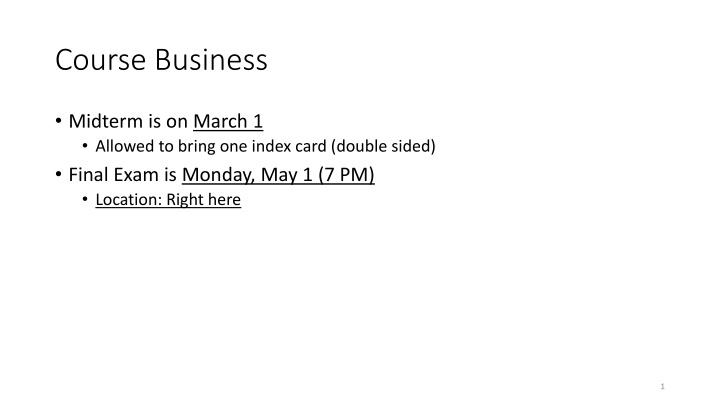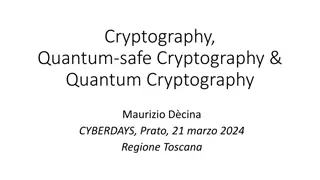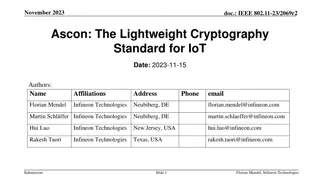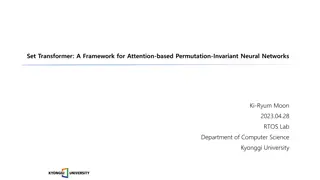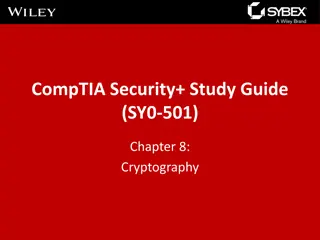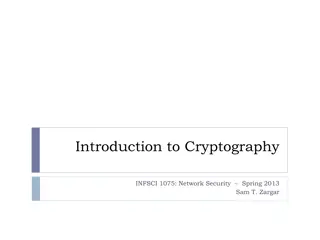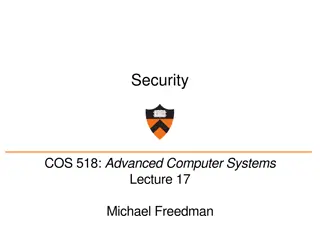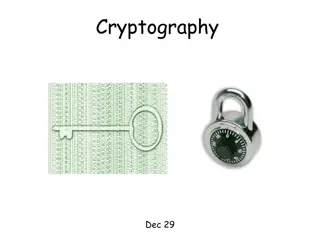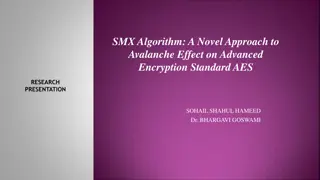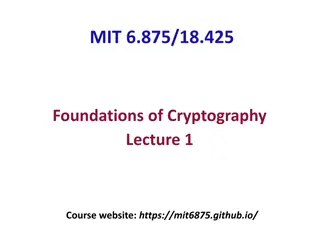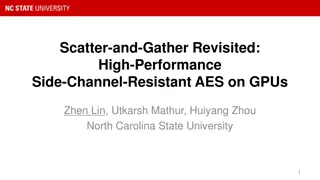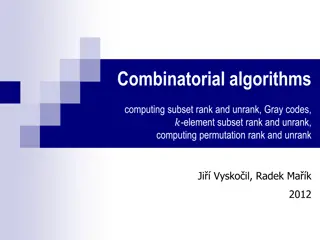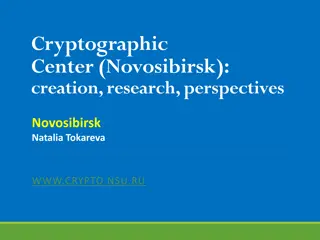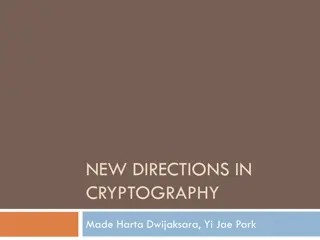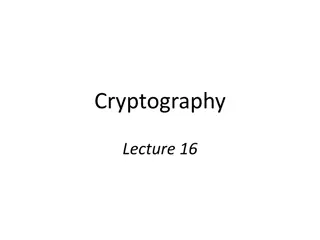Practical Cryptography Topics: AES and Substitution Permutation Networks
Dive into the world of practical cryptography with insights into the Advanced Encryption Standard (AES) and Substitution Permutation Networks. Explore the history of AES, its design principles, key sizes, and basic operations like AddRoundKey, SubBytes, ShiftRows, and MixColumns. Understand the significance of S-boxes in Substitution Permutation Networks and how they contribute to secure encryption. Delve into Proposition 6.3 to grasp the concept of permutations in keyed functions. Enhance your knowledge of symmetric key primitives, differential cryptanalysis, and hashing techniques.
Download Presentation

Please find below an Image/Link to download the presentation.
The content on the website is provided AS IS for your information and personal use only. It may not be sold, licensed, or shared on other websites without obtaining consent from the author.If you encounter any issues during the download, it is possible that the publisher has removed the file from their server.
You are allowed to download the files provided on this website for personal or commercial use, subject to the condition that they are used lawfully. All files are the property of their respective owners.
The content on the website is provided AS IS for your information and personal use only. It may not be sold, licensed, or shared on other websites without obtaining consent from the author.
E N D
Presentation Transcript
Course Business Midterm is on March 1 Allowed to bring one index card (double sided) Final Exam is Monday, May 1 (7 PM) Location: Right here 1
Cryptography CS 555 Topic 18: AES, Differential Cryptanalysis, Hashing 2
Recap Goals for This Week: Practical Constructions of Symmetric Key Primitives Last Class: DES/3DES 16 round Feistel Network DES can now be broken by brute-force attacks in practice Today s Goals: AES/Hash Functions 3
Advanced Encryption Standard (AES) (1997) US National Institute of Standards and Technology (NIST) announces competition for new block cipher to replace DES Fifteen algorithms were submitted from all over the world Analyzed by NIST Contestants given a chance to break competitors schemes October, 2000 NIST announces a winner Rijndael Vincent Rijmen and Joan Daemen No serious vulnerabilities found in four other finalists Rijndael was selected for efficiency, hardware performance, flexibility etc 4
Advanced Encryption Standard Block Size: 128 bits (viewed as 4x4 byte array) Key Size: 128, 192 or 256 Essentially a Substitution Permutation Network AddRoundKey: Generate 128-bit sub-key from master key XOR with current state SubBytes: Each byte of state array (16 bytes) is replaced by another byte according a a single S-box (lookup table) ShiftRows shift ith row by i bytes MixColumns permute the bits in each column 5
Substitution Permutation Networks S-box a public substitution function (e.g. S Perm8). S is not part of a secret key, but can be used with one Note: there are only n! possible bit mixing permutations of [n] as opposed to 2n! Permutations of {0,1}n f(x) = S x ? Input to round: x, k (k is subkey for current round) 1. Key Mixing: Set x x ? 2. Substitution: x S1x1 S2x2 S8x8 3. Bit Mixing Permutation: permute the bits of x to obtain the round output 6
Substitution Permutation Networks Proposition 6.3: Let F be a keyed function defined by a Substitution Permutation Network. Then for any keys/number of rounds Fk is a permutation. Why? Composing permutations f,g results in another permutation h(x)=g(f(x)). 7
Advanced Encryption Standard Block Size: 128 bits Key Size: 128, 192 or 256 Key Mixing Essentially a Substitution Permutation Network AddRoundKey: Generate 128-bit sub-key from master key, XOR with current state array SubBytes: Each byte of state array (16 bytes) is replaced by another byte according a single S-box (lookup table) ShiftRows MixColumns Permutation Substitution 8
AddRoundKey: Round Key (16 Bytes) 00001111 10100011 11001100 01111111 State 11110000 01100010 00110000 11111111 = 11111111 11000001 11111100 10000000 9
State 11111111 11000001 11111100 10000000 SubBytes (Apply S-box) S(11111111) S(11000001) S( ) S(11111100) S( ) S(10000000) S( ) 10
State S(11111111) S(11000001) S( ) S(11111100) S( ) S(10000000) S( ) Shift Rows S(11111111) S(11000001) S( ) S( ) S(11111100) S( ) S(10000000) 11
State S(11111111) S(11000001) S( ) S( ) S(11111100) S( ) S(10000000) Mix Columns Invertible (linear) transformation. Key property: if inputs differ in b>0 bytes then output differs in 5-b bytes (minimum) 12
AES We just described one round of the SPN AES uses 10 rounds (with 128 bit key) 12 rounds (with 192 bit key) 14 rounds (with 256 bit key) 13
AES Attacks? Side channel attacks affect a few specific implementations But, this is not a weakness of AES itself Timing attack on OpenSSL s implementation AES encryption (2005, Bernstein) (2009) Attack on 11 round version of AES recovers 256-bit key in time 270 But AES is 14 round (with 256 bit key) so the attack doesn t apply in practice (2009) Attack on 192-bit and 256 bit version of AES recovers 256-bit key in time 299.5. First public cipher approved by NSA for Top Secret information 14
Differential Cryptanalysis Basic Goal: Find specific differences in the input that lead to specific differences in output with probability (slightly) greater than we would expect for a random permutation Suppose that we pick ?1 and ?2 uniformly at random subject to the constraint ?1 ?2= ? Question: What is the probability that? ???1 ???2= ? 15
Differential Cryptanalysis Suppose that we pick ?1 and ?2 uniformly at random subject to the constraint ?1 ?2= ? Question: What is the probability that? ???1 ???2= ? Answer for Ideal Cipher: 2 ? Possible Answer for Weak Block Cipher:? 2 ? Attacker who finds ?and ?such that ? 2 ? can exploit this observation 16
Differential Cryptanalysis Start by finding differential(s) for S-Box How? Brute force! Use differential for S-box to construct differential for entire cipher 17
Differential Cryptanalysis Question: What is the probability that? ???1 ???2= ? Answer for Ideal Cipher: 2 ? Example 1: FEAL-8. Differential cryptanalysis can quickly recover key after just 1,000 chosen plaintexts Example 2: DES. Differential cryptanalysis can quickly recover key after ``just 243 known plaintext/ciphertext pairs Differential Cryptanalysis discovered (publicly) after DES NSA knew about differential cryptanalysis before DES 18
Hash Function from Block Ciphers Davies-Meyer Construction (?,?) = ??? ? How to prove collision resistance? We don t actually know how if we only use the assumption that F is strong pseudorandom permutation We can prove collision resistance in the ideal-cipher model All parties have oracle access to truly random keyed permutation F, F-1 19
Hash Function from Block Ciphers Davies-Meyer Construction (?,?) = ??? ? Theorem: If F is modeled as an ideal cipher then an attacker making ? < 2?/2 queries to F finds a collision with probability at most ?2 2?. 20
Davies-Meyer Construction Security proof in ideal-cipher model may not translate to real world Example: Davies-Meyer + DES is broken. 21
Other Hashing Algorithms MD5 Chinese cryptanalysists found a collision in 2004 Collisions can now be found on a desktop PC in < 60 seconds Extension of attacks generates controlled collisions SHA1, SHA2 Use Davies-Meyer Construction with special block ciphers Theoretical analysis: can find SHA1 collision in time 280. SHA2 is widely deployed (e.g., in Bitcoin, PBKDF2-SHA256) 22
SHA3 (Keccak) NIST announced public competition in 2007 for SHA3 In response to weaknesses of SHA1 and MD5 (2012) NIST selected Keccak as the winner of the competition Based on an (unkeyed) permutation with large block length Uses sponge construction instead of Merkle-Damgard to handle arbitrary length inputs Very different from SHA1 and SHA2 Proof of security in random-permutation model Weaker than ideal-cipher model 23
Next Class Read Katz and Lindell 7.1-7.2, 7.5 Theoretical Foundations for Symmetric Key Cryptography One Way Functions Pseudo randomness 24
